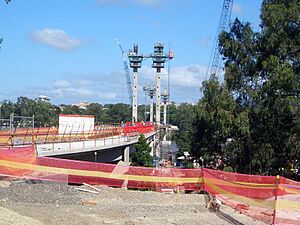Eleanor Schonell Bridge facts for kids
Quick facts for kids Eleanor Schonell |
|
|---|---|
 |
|
| Coordinates | 27°29′52″S 153°01′16″E / 27.497781°S 153.020981°E |
| Carries | Buses, pedestrians, bicycles. |
| Crosses | Brisbane River |
| Locale | Brisbane, Queensland, Australia |
| Official name | Eleanor Schonell Bridge |
| Named for | Eleanor Schonell |
| Characteristics | |
| Design | Cable-stayed bridge |
| Total length | 390 metres (1,280 ft) |
| History | |
| Opened | 17 December 2006 |
The Eleanor Schonell Bridge is a special bridge in Brisbane, Queensland, Australia. Many people know it as the Green Bridge. It's a long bridge, about 390 metres (1,280 feet) in length. This bridge crosses the Brisbane River. It connects Dutton Park with The University of Queensland's St Lucia campus.
The bridge opened on 17 December 2006. It was the first bridge in Australia built only for buses, cyclists, and pedestrians. This means cars cannot use it. Building the bridge cost about $55.5 million. Before the bridge, a ferry service helped people cross the river. This ferry service stopped when the bridge opened.
Contents
Building the Eleanor Schonell Bridge
The idea for the bridge's design came from Bruce Ramsay. A company called John Holland Group did the detailed design and built the bridge.
Building the bridge also included some other big projects. A new road was built in Dutton Park. Annerley Road was made wider. A new bus station was built for the University of Queensland. Also, College Road in St Lucia was permanently changed.
The bridge is also connected to the Eastern Busway. This busway helps link the bridge to the Queensland Rail City network at Park Road station. It also connects to the South East Busway.
Bus Services Using the Bridge
When the bridge opened, new bus services started. These buses use the bridge to help people travel easily. TransLink announced three new bus routes: 109, 169, and 209.
The 109 bus started on 18 December 2006. It connects the University of Queensland (UQ) to the city centre. The 169 and 209 services began in February 2007. The 169 links UQ with Eight Mile Plains and Garden City. The 209 connects UQ with Carindale.
Later, more services were added. The 139 bus started in July 2007. It helps students from Sunnybank and Sunnybank Hills get to UQ. This bus runs only on weekdays during university terms. In October 2008, the 192 service was extended. It now connects UQ to West End and Highgate Hill. The newest service is the 29 route. It's a shuttle bus that runs every five minutes. It connects the Woolloongabba Bus Station to UQ Lakes.
How the Bridge Helps Travel
The Eleanor Schonell Bridge has greatly improved how people cross the river. Before the bridge, people used ferries. The bridge can carry many more people than the ferries. It also makes river crossings faster, especially during quieter times.
The bridge became very popular quickly. So many people used it that extra buses were needed. The new Boggo Road busway also helps. It makes it easier to switch between trains and buses at Park Road Station. This has opened up the St. Lucia area to more travellers.
The bridge also helps people on the north side of the river. They can now cycle to the city centre in about 15 minutes. They use Annerley Road and the Goodwill bridge.
The St. Lucia End of the Bridge
At the St. Lucia end, the road for buses stops in a cul-de-sac. This means buses cannot drive further into the streets of the university or St. Lucia suburb. However, there is a separate path for cyclists. This path leads directly to other bike paths away from the bridge. This design was planned so that buses would not drive through the campus or the suburb.
Why it's Called Eleanor Schonell Bridge
On 28 August 2006, the Brisbane Lord Mayor, Campbell Newman, announced the bridge's official name. It would be called the Eleanor Schonell Bridge.
An expert group helped choose the name. They looked at hundreds of ideas from the public. They picked three names: Eleanor Schonell Bridge, Hawken Bridge, and University Bridge.
The bridge was named after Eleanor Schonell. She was a very kind and generous person. She made important discoveries about how to test for dyslexia. This is a learning difficulty that affects reading. She also did important work with children who had cerebral palsy. She helped children with intellectual disabilities too.
During its planning and building, the bridge was known as the "Green Bridge." This was because it was built to help with sustainable transport. Even after its official naming, many people still call it the Green Bridge.
Green Power for the Bridge
The Eleanor Schonell Bridge uses energy-saving features. It has special lights that use less power. These lights are also designed to reduce their impact on the surrounding area. The bridge also has timers and remote controls for its lights. This helps save energy by turning off lights when they are not needed.
A large solar roof helps power the bridge. This roof has 108 solar panels. These panels create electricity from the sun. The electricity goes back into the main power grid. This helps to balance the electricity the bridge uses at night.
Gallery






